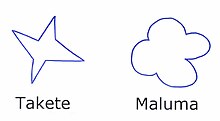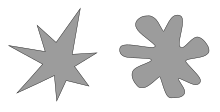Wolfgang Köhler (psychologist)
Wolfgang Köhler (born January 9, jul. / 21st January 1887 greg. In Tallinn , Russian empire , now Tallinn , Estonia ; † 11. June 1967 in Enfield , New Hampshire , United States ) applies with Max Wertheimer and Kurt Koffka as one of the Founder of Gestalt psychology and Gestalt theory .
Live and act
Wolfgang Köhler was the son of Franz Köhler , director of the cathedral school in Reval. In 1893 his father went to Wolfenbüttel as a teacher and librarian , where Wolfgang Köhler attended high school. Köhler studied philosophy , natural sciences and psychology at the University of Tübingen , the University of Bonn and the Berlin Friedrich Wilhelms University ; one of his teachers in physics was u. a. Max Planck . In 1909 he did his doctorate under Carl Stumpf in psychoacoustics on "acoustic investigations". Koehler then worked at the Psychological Institute in Frankfurt am Main as an assistant to Friedrich Schumann . Here he got to know Max Wertheimer and Kurt Koffka , who jointly founded a new branch of psychology, Gestalt psychology (“ Berlin School ”).
From 1914 to 1920 he headed the anthropoid station of the Prussian Academy of Sciences in Tenerife , initiated by Max Rothmann , where he carried out his famous research on the use of tools and the problem-solving behavior of chimpanzees . On cognitive psychology in great apes , Köhler published his revolutionary work Intelligence tests on anthropoids in 1917 . Koehler's work, which appeared in the time of behaviorism , was initially almost completely ignored, and it was only since the late 1950s that the mental abilities of animals have been scientifically investigated again. The financial support of his research facility was also discontinued after the end of the First World War by the Prussian Academy of Sciences for lack of money, which is why the station was abandoned and five female chimpanzees from Cameroon were placed in the care of the Berlin zoological garden in 1920 . After the anthropoid ward closed, Köhler also returned to Germany and became a professor at the University of Göttingen for a short time , but then moved to the Friedrich-Wilhelms-Universität zu Berlin (today: Humboldt University), where he was director of psychology from 1922 to 1935 Institute was; one of his Berlin students was a. a. Wolfgang Metzger .
During the 1920s, Köhler also became one of the best-known psychologists internationally. During a stay in the USA in 1925/26, four American universities (including Harvard and Yale ) offered him chairs or visiting professorships. However, Köhler decided to stay in Berlin.
In 1933, Köhler was the only German university professor of psychology to protest publicly in a newspaper article against the dismissal of Jewish professors by the National Socialists . After his institute had repeatedly been the target of National Socialist attacks and interventions in 1934/35, Köhler applied for his retirement in August 1935. At the end of September, he was then released. In the same year he left Germany for good and accepted a professorship at Swarthmore College , Pennsylvania, from where he worked as editor of the journal Psychological Research , which he co-founded, until she was hired in 1938 . His brother, the art historian Wilhelm Koehler , had emigrated to the USA in 1934.
The American psychologist Mary Henle , one of his closest collaborators in American exile, published the Selected Papers of Wolfgang Köhler in 1971 (Liveright: New York).
Today, Wolfgang Köhler's work is attracting increasing attention again, including in brain research . MN Eagle and JC Wakefield, for example, point out that the discovery of mirror neurons was already anticipated in Koehler's postulate of a psychophysical isomorphism.
Maluma and Takete
Fundamental research to prove the quality of appearance was carried out by Wolfgang Köhler in 1929. Köhler presented test subjects with a round and an angular figure and asked them to assign the word Maluma or the word Takete to the shapes . In 90% of the cases, the subjects assigned the round shape to Maluma and the pointed shape to Takete .
From this, Köhler derived the proof that there is an intuitive, emotional connection between language and optical representations, i.e. sounds correspond to the perception of shapes.
Bouba and Kiki
In 2001, VS Ramachandran and Edward Hubbard replicated Köhler's experiment with the non- words kiki and bouba and asked US-Americans and Indian Tamil speakers to assign them to the adjacent outlines. In both groups, 95% to 98% assigned the curvy shape to bouba and the jagged shape to kiki . The human brain should therefore combine abstract forms and sounds in a consistent way.
Honors
- In 1928 Köhler was elected to the American Academy of Arts and Sciences , in 1947 to the National Academy of Sciences .
- From 1956 to 1959 Koehler was President of the American Psychological Association .
- In 1962 he was awarded the Wilhelm Wundt Medal of the German Society for Psychology .
- In 1962 he was made honorary citizenship of the Free University of Berlin .
In recognition of Köhler's work, the establishment of the Max Planck Institute for Evolutionary Anthropology for cognitive research in great apes was named Wolfgang Köhler Primate Research Center . The great ape enclosure of the research facility can be viewed by visitors to the zoo as Pongoland .
Publications (selection)
- 1917: Intelligence tests on anthropoids (published in 1925 in English translation under the title The Mentality of Apes ).
- 1920: The physical forms at rest and in a stationary state. A natural-philosophical investigation.
- 1921: Intelligence tests on great apes . Berlin (Springer), reprint 1963
- 1929: Gestalt Psychology (published in German translation in 1933 under the title Psychological Problems ).
- 1938: The place of value in a world of facts (published in 1968 in German as values and facts ).
- 1969: The task of Gestalt Psychology (published in 1971 in German as The tasks of Gestalt psychology ).
literature
- Rudolf Bergius: Köhler, Wolfgang. In: New German Biography (NDB). Volume 12, Duncker & Humblot, Berlin 1980, ISBN 3-428-00193-1 , pp. 302-304 ( digitized version ).
- Wolfgang Koehler . In: Karin Orth: Expulsion from the science system. Commemorative book for the committee members of the DFG expelled under National Socialism, Stuttgart: Steiner 2018 (Contributions to the History of the German Research Foundation; 7), pp. 202-214. ISBN 978-3-515-11953-5
Web links
- Literature by and about Wolfgang Köhler in the catalog of the German National Library
- Short biography and references to digital sources in the Virtual Laboratory of the Max Planck Institute for the History of Science (English)
- Wolfgang Köhler's biography on the website of the Wolfgang Köhler Primate Research Center
Individual evidence
- ^ Entry in the baptismal register of the cathedral in Reval .
- ↑ Köhler's biography on the website of the University of Würzburg. Retrieved April 21, 2019 .
- ↑ NN: Tenerife Chimpanzees. In: JAMA . Volume 76, No. 6, 1921, p. 394, full text .
- ↑ Michael Grüttner among others: The Berlin University between the world wars 1918-1945. Berlin 2012 (= History of the University of Unter den Linden , Vol. 2), p. 64 f.
- ↑ Ulf Geuter: The professionalization of German psychology under National Socialism. Frankfurt am Main: Suhrkamp, 1988, p. 102
- ↑ Sven Kinas: mass layoffs and emigration. In: Michael Grüttner among others: The Berlin University between the world wars 1918-1945. Berlin 2012 (= History of the University of Unter den Linden , vol. 2), p. 382 f.
- ^ MN Eagle, JC Wakefield: Gestalt Psychology and the Mirror Neuron Discovery . In: Gestalt Theory. Volume 29, 2007, pp. 59-64.
- ↑ Article in oktopus <br /> Takete and Maluma - An investigation into the origin of (iconic) ideas in the early stages of product design.
| personal data | |
|---|---|
| SURNAME | Koehler, Wolfgang |
| BRIEF DESCRIPTION | Co-founder of Gestalt psychology and Gestalt theory |
| DATE OF BIRTH | January 21, 1887 |
| PLACE OF BIRTH | Reval , Estonia |
| DATE OF DEATH | June 11, 1967 |
| Place of death | Enfield, New Hampshire |

